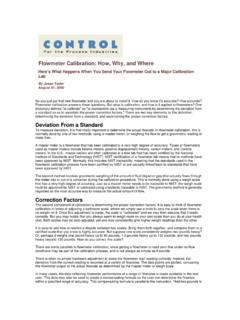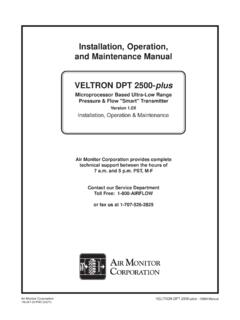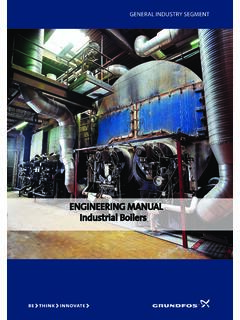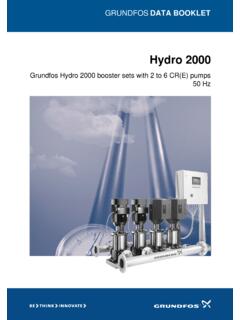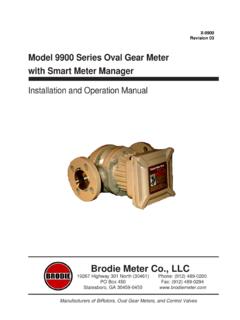Transcription of Using meters to measure steam flow - Flow Research
1 April 1998 Plant Engineering SELECTING NEW TECHNOLOGY: PROBLEM SOLVING Using meters to measure steam flow Jesse L. Yoder, , Senior Analyst, Automation Research Corp., Dedham, MA When people hear about fluid measurement, they usually think of checking either liquid or gas flow. This belief is natural, since about 90% of fluid measurements are for these two applications. In a worldwide survey of flowmeter users, 68% measured liquids, 22% gas, and only 10% steam . While 10% may not seem like a large percentage, it represents a significant number of measurements. Many companies measure steam for purposes of internal custody transfer and for utility applications in power generation and chemical plants.
2 steam types While all steam may look the same, the way it is measured varies with the type: wet, saturated, or superheated. Wet steam Wet steam is probably the most difficult type to measure . It contains both condensed hot-water particles and steam , and is considered two-phase flow. Wet steam is difficult to measure with any of the technologies currently available, and accuracies can vary. Saturated steam Saturated steam occurs at a particular pressure and Key Concepts lTypes of steam --wet, saturated, and superheated--influence selection of the flow measuring device. lAs measurement becomes more accurate, the meter's price increases.
3 LInstallation varies for each type of flowmeter. Page 1 of 6 Using meters to measure steam flow - 0498 Plant Engineering4/23/02file://C:\Living%20 Database\Articles\ Using %20meters%20 Plant% temperature when a state of equilibrium exists between liquid and vapor states; for example, at the end of the boiling process when only steam is present. Superheated steam Superheated steam is at a higher temperature than the saturation temperature at the same pressure. Thus, it occurs when saturated steam is subjected to an increase in temperature while the pressure remains constant or is decreased while the temperature remains the same.
4 In a boiler, steam is saturated. As steam leaves a boiler, a pressure drop is created by the flow. Reduced pressure, along with a relatively constant temperature, results in superheated steam , which acts as a gas and conforms to general gas laws. Flowmeter types steam flow is measured with several types of flowmeters: differential pressure-based (orifice plates, flow nozzles, venturi tubes, and averaging pitot tubes), vortex, Coriolis, and ultrasonic. For specific applications contact the manufacturer for recommendations based on steam type, flow rate, and operating conditions. Differential pressure-based flowmeters Differential pressure-based flowmeters measure steam flow by Using a primary element to cause a pressure drop.
5 Flow rate varies with the square root of the pressure drop across the primary element. Pressure drop is measured with a differential pressure (DP) transmitter. Orifice plates contain a hole or orifice through which liquid passes. Upstream and downstream piping are required to condition the flow and provide for accurate measurement. Pressure is measured upstream and downstream from the orifice plate with a DP transmitter, which then calculates the flow rate. Flow nozzles (Fig. 1) have a narrow opening for steam to pass through. One of the most common uses of flow nozzles in the power industry is to measure the amount of steam going to a turbine.
6 Fig. 1. Flow nozzles for high-velocity and high-temperature Page 2 of 6 Using meters to measure steam flow - 0498 Plant Engineering4/23/02file://C:\Living%20 Database\Articles\ Using %20meters%20 Plant% They are used primarily for high-velocity and high-temperature applications, and work best with fluids whose Reynolds numbers are at or above 10,000. Venturi tubes consist of a tapered inlet and outlet with a straight section in the middle that is narrower than the pipe diameter. They have a length of about eight pipe diameters. Pressure drop is lower than with orifice plates. Upstream pipe requirements are less stringent than those for orifice plates or flow nozzles, and they do not require straightening vanes.
7 On the other hand, venturi tubes are more difficult to manufacture with precision than orifice plates or flow nozzles, which makes them more expensive. Their size makes them difficult to inspect and change. Averaging pitot tubes (Fig. 2) consist of an insertion sensor spanning the full pipe diameter that detects an impact and reference pressure through a series of ports on the upstream and downstream faces. By averaging pressure signals, a differential signal is created that resembles the signal produced by an orifice plate meter. Vortex flowmeters (12636 bytes)jobs are usually manufactured from stainless steel to prevent corrosion of the polished throat.
8 Fig. 2. Averaging pitot tubes span the entire pipe diameter, are easy to install, and provide an inexpensive way to measure steam . (Courtesy Rosemount, Inc.) (13844 bytes) Page 3 of 6 Using meters to measure steam flow - 0498 Plant Engineering4/23/02file://C:\Living%20 Database\Articles\ Using %20meters%20 Plant% Vortex flowmeters (Fig. 3) are becoming widely used for steam flow measurement. They operate on a principle known as the von Karman effect. According to this principle, fluid that passes a bluff body generates vortices alternately on either side of the body. Frequency of vortices generated is proportional to the flow rate of the fluid.
9 Although vortex flowmeters cost more than DP-based transmitters and orifice plates, their installed cost is comparable to that of orifice plate flowmeters because of the additional expense of the mounting systems and pressure taps required for orifice plate meters . Vortex meters , like DP-based flowmeters, are also sensitive to inlet flow conditions, and may require straightening vanes or straight pipe runs to obtain required accuracy. Coriolis flowmeters Coriolis flowmeters directly measure mass flow rate. They have one or more bent, straight, or U-shaped vibrating tubes in the fluid stream. As the fluid passes through the tubes, they twist.
10 The amount of tube twisting is directly proportional to mass flow. This meter can also be used for heat measurement of low-pressure, superheated steam . The chief advantage of Coriolis flowmeters is providing highly accurate measurements of mass flow rate without flow conditioning or accessory devices such as pressure or temperature measurement. Ultrasonic flowmeters Ultrasonic flowmeters measure the time it takes an ultrasonic pulse to travel back and forth across a pipe at an angle. When the (16104 bytes)Fig. 3. Vortex flowmeters have a barlike or bluff construction that allows for the passage of dirt. (Courtesy Yokogawa Industrial Automation) Page 4 of 6 Using meters to measure steam flow - 0498 Plant Engineering4/23/02file://C:\Living%20 Database\Articles\ Using %20meters%20 Plant% travels with the flow, it moves quicker than when it travels against the flow.
